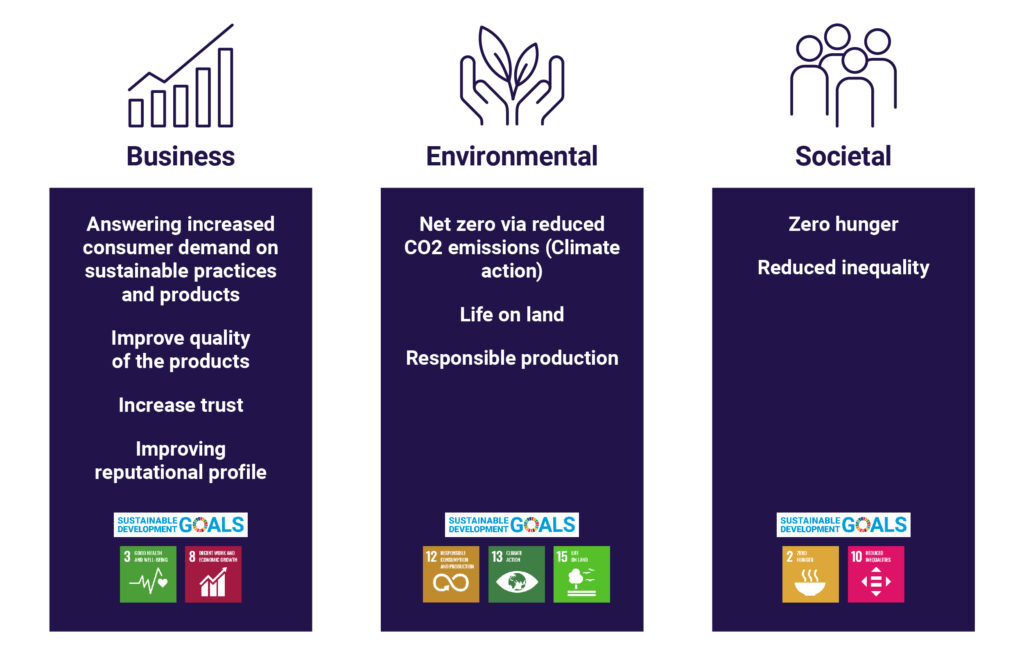Frames • 19 June 2023
Regenerative Agriculture
A call to action for the future of the food system. How can the CPG industry navigate the demand for higher food production in a more sustainable and economically viable way?
A call to action for the future of the food system. How can the CPG industry navigate the demand for higher food production in a more sustainable and economically viable way?
The term ‘regenerative agriculture’ is complex. There isn’t widespread agreement on a definition, and in many cases, ideas on the matter blur with ‘organic farming’, which is a separate term. However, we take regenerative agriculture to mean a conservation and rehabilitation approach to food and farming systems, one that has an important role to pay in carbon sequestration. This focuses on topsoil regeneration, favoring biodiversity, improving the water cycle, increasing resilience in the climate crisis, and strengthening the health and vitality of farm soil.
“Modern agriculture has altered the face of the planet more than any other human activity. We need to urgently rethink our global food systems…”
Ibrahim Thiaw, Executive Secretary of the UNCCD United Nations Convention to Combat Desertification
There is a tension between the increased demand for food, and our ability to produce it. Currently, a third of the world’s land and three quarters of its freshwater are used in food production. Up to 40% of the planet’s land is already degraded and there is a 70% expected increase in demand on our agricultural system in the next 30 years.
We need new possibilities to produce food sustainably, while restoring the climate at the same time.
Even if the benefits of RA can be huge, its implementation is still lagging behind. A lack of infrastructural investment and legislation are the key challenges to overcome. To bring more focus to it, and accelerate attention towards RA, a few soft challenges should be managed:
We can see that regenerative agriculture is increasingly notable in sustainability reporting. It can be a key enabler for companies to meet their business, environmental and societal goals.
The opportunities presented by regenerative agriculture for your brand strategy are vast and varied. But all transformation must be driven by strategic thinking and deep insight into the factors at play.
Companies have an important role to play in realising the potential benefits of RA. We identified different opportunities in both a reactive and proactive approach that can help companies and brands to get substantial payback while contributing to a better planet.

The CPG industry can either be proactive or reactive in the pursuit of this opportunity. Are your competitors already leading the way? And how will you compare?
We explore the world of regenerative agriculture and its value for brands in the CPG industry. Listen in as Sevendots Partners Stephen Factor and Elisa Costa unravel the mysteries of RA and its potential impact on the CPG industry.
In this episode, Stephen and Elisa discuss:
This article explores the way regenerative practices can be understood to feed economic activity that serves long-term sustainability, with better outcomes for both humankind and the planet.
Growth, Sustainability 20 December 2021
The CPG industry has been essential for economic growth. With change comes a new source of value generation. Introducing our take on the future of value generation for the generations to come.
Innovation & Disruption 28 March 2022
The future of food products is changing. But alongside the challenges of demand, we have another big challenge to overcome: that of consumer expectations, and in particular, the way the younger generations view the role of technology in their food supply. In this conversation with Valerio Nannini, we look at the tension between a yearning for naturalness and the need for new solutions to the world's food supply problems.
CPG Trends 22 August 2022
There are two important sides to sustainability for CPG businesses: What actions to take and how to tell the story of those actions to your consumers. Here we break down key takeaways for decision makers to ensure both elements are properly managed in a balanced and effective way.
Contact us to learn more using the link below.
Get in touch